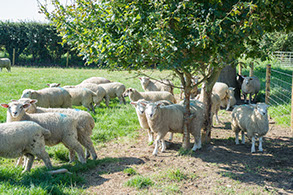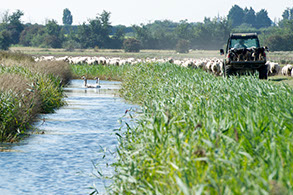
CHANDLER & DUNN
FARMING FOR THE FUTURE

ROMNEY MARSH SHEEP
"All our animals are reared outdoors on the natural marshlands of the Ash Levels."

In the early 50's the company purchased the neighbouring arable and sheep farm. Today the flock is about 550 Romney breeding ewes - ideally suited to marsh grazing along the River Stour.
Busy all year round
Apart from the everyday checking on the welfare of the flock, there is always something to plan for.
Spring lambing is not the only busy time of year. Autumn, is also very important as breeding ewes and tups [rams] have to be MOT'd to make sure they are fit and in the optimum condition to breed.
The tups are put in with the ewes on November 5th - giving us a lambing start date of April 1st; and taken away from the ewes after eight weeks so it gives a finish date to lambing in June.
In the middle of January we scan the ewes to see how many lambs they're carrying, and this enables us to sort and feed the ewes accordingly.
Prior to lambing, the ewes are 'crutched' (have their bottoms shaved) so it is easier for lambs to find their mother's teats instead of a mouth full of wool. At the same time, we vaccinate the ewes against certain diseases and they pass on their immunity to their unborn lambs.
From April 1st, we are busy, busy, busy. After eight weeks or so ewes and lambs are happily settled in the fields enjoying the sunshine and fresh grass. As there is a danger of blowflies laying their eggs on the unsuspecting lambs, we have to treat all the sheep to keep the flies away. This we do by putting them through a plunge bath which also protects them from ticks and mites.
Middle of June to early July it's time to wear the new summer fashions for shearing time. The following month its time to wean the lambs, and then it starts all over again.




CHANDLER & DUNN LTD